
matthew capek
@matthewcapek.bsky.social
sensory systems, evolution of behavior and cross-kingdom interactions, special interest in insects and kin 🪰🪲 | postdoctoral fellow at Bellono Lab, Harvard MCB | PhD from @GallioLab | he/they 🏳️🌈
Reposted by matthew capek
Most Nature papers are published in Current Biology
DNA from Napoleon’s 1812 army identifies the pathogens likely responsible for the army’s demise during their Russian retreat. www.cell.com/current-biol...
Nicolás Rascovan & colleagues
@currentbiology.bsky.social
Nicolás Rascovan & colleagues
@currentbiology.bsky.social

October 26, 2025 at 3:15 PM
Most Nature papers are published in Current Biology
Reposted by matthew capek
Although highly topical, kleptoparasitism does not get nearly the attention it deserves!
Here, a plant exploits the kleptoparasitic behavior of a fly that likes to snatch ants killed by spiders.
🕷️🐜🪰🌿
So the thief itself gets taken advantage of. Nice going, plants!
www.cell.com/current-biol...
Here, a plant exploits the kleptoparasitic behavior of a fly that likes to snatch ants killed by spiders.
🕷️🐜🪰🌿
So the thief itself gets taken advantage of. Nice going, plants!
www.cell.com/current-biol...

Olfactory floral mimicry of injured ants mediates the attraction of kleptoparasitic fly pollinators
Mochizuki reports a plant that lures pollinating flies by imitating the scent of ants
injured by predators. This study reveals the first known case of ant mimicry in flowers
and uncovers previously un...
www.cell.com
September 26, 2025 at 4:59 PM
Although highly topical, kleptoparasitism does not get nearly the attention it deserves!
Here, a plant exploits the kleptoparasitic behavior of a fly that likes to snatch ants killed by spiders.
🕷️🐜🪰🌿
So the thief itself gets taken advantage of. Nice going, plants!
www.cell.com/current-biol...
Here, a plant exploits the kleptoparasitic behavior of a fly that likes to snatch ants killed by spiders.
🕷️🐜🪰🌿
So the thief itself gets taken advantage of. Nice going, plants!
www.cell.com/current-biol...
Reposted by matthew capek
New review on how changes in cell type composition in and outside the brain contribute to the evolution of behavior. 🧪
authors.elsevier.com/a/1lihM,LqAZ...
authors.elsevier.com/a/1lihM,LqAZ...

September 8, 2025 at 3:41 PM
New review on how changes in cell type composition in and outside the brain contribute to the evolution of behavior. 🧪
authors.elsevier.com/a/1lihM,LqAZ...
authors.elsevier.com/a/1lihM,LqAZ...
Reposted by matthew capek
Corey Allard et al asks how “solar-powered” slugs maintain stolen chloroplasts from their diet for photosynthesis and starvation resistance. @cellpress.bsky.social, @harvardmcb.bsky.social, @harvardmed.bsky.social
www.cell.com/cell/fulltex...
www.cell.com/cell/fulltex...

June 25, 2025 at 4:21 PM
Corey Allard et al asks how “solar-powered” slugs maintain stolen chloroplasts from their diet for photosynthesis and starvation resistance. @cellpress.bsky.social, @harvardmcb.bsky.social, @harvardmed.bsky.social
www.cell.com/cell/fulltex...
www.cell.com/cell/fulltex...
Reposted by matthew capek
Flybase lost all of the NIH support overnight - it is a disaster for the community. Please consider donating. I just did! www.philanthropy.cam.ac.uk/give-to-camb...

Drosophila Genetic Database
The Drosophila Genetic Database, FlyBase, is on the brink of collapse due to the sudden termination of the FlyBase NIH grant, which includes salaries for 5 literature curators based at the University ...
www.philanthropy.cam.ac.uk
June 3, 2025 at 6:23 PM
Flybase lost all of the NIH support overnight - it is a disaster for the community. Please consider donating. I just did! www.philanthropy.cam.ac.uk/give-to-camb...
Reposted by matthew capek
Happy to see this out now:
Olfactory projection neuron rewiring in the brain of an ecological specialist: Cell Reports www.cell.com/cell-reports...
In a team effort with @bentonlab.bsky.social 's lab we establish new genetic tools in #drosophila sechellia and compare single central brain neurons.
Olfactory projection neuron rewiring in the brain of an ecological specialist: Cell Reports www.cell.com/cell-reports...
In a team effort with @bentonlab.bsky.social 's lab we establish new genetic tools in #drosophila sechellia and compare single central brain neurons.

Olfactory projection neuron rewiring in the brain of an ecological specialist
Dürr et al. develop advanced genetic tools in the host specialist D. sechellia to
study its olfactory system neuroanatomy. They show via single-cell labeling, tracing,
and quantitative comparison of o...
www.cell.com
April 28, 2025 at 7:08 AM
Happy to see this out now:
Olfactory projection neuron rewiring in the brain of an ecological specialist: Cell Reports www.cell.com/cell-reports...
In a team effort with @bentonlab.bsky.social 's lab we establish new genetic tools in #drosophila sechellia and compare single central brain neurons.
Olfactory projection neuron rewiring in the brain of an ecological specialist: Cell Reports www.cell.com/cell-reports...
In a team effort with @bentonlab.bsky.social 's lab we establish new genetic tools in #drosophila sechellia and compare single central brain neurons.
Reposted by matthew capek
Now out in #ProcB 🧪
Ancestral complexity and constrained diversification of the ant olfactory system 🐜
Expertly led by Simon Marty and Antoine Couto, funded by @leverhulme.ac.uk and @agencerecherche.bsky.social 🙏🏻
#socialinsects @bristolbiosci.bsky.social @cnrs.fr
Ancestral complexity and constrained diversification of the ant olfactory system 🐜
Expertly led by Simon Marty and Antoine Couto, funded by @leverhulme.ac.uk and @agencerecherche.bsky.social 🙏🏻
#socialinsects @bristolbiosci.bsky.social @cnrs.fr
new from our project with Patrizia d’Ettore and Jean-Christoph Sandoz’s labs, led by Simon Marty & Antoine Couto, with Neven Brard and Erika Dawson - comparing the olfactory pathway across ants, from sensillae to specialised antennal lobe structures 🐜
www.biorxiv.org/content/10.1...
www.biorxiv.org/content/10.1...
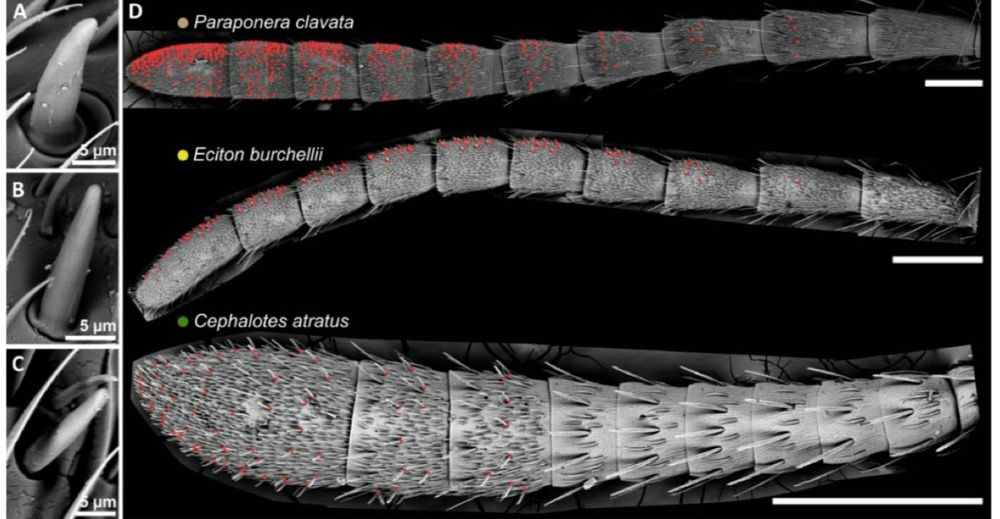
April 30, 2025 at 5:01 PM
Now out in #ProcB 🧪
Ancestral complexity and constrained diversification of the ant olfactory system 🐜
Expertly led by Simon Marty and Antoine Couto, funded by @leverhulme.ac.uk and @agencerecherche.bsky.social 🙏🏻
#socialinsects @bristolbiosci.bsky.social @cnrs.fr
Ancestral complexity and constrained diversification of the ant olfactory system 🐜
Expertly led by Simon Marty and Antoine Couto, funded by @leverhulme.ac.uk and @agencerecherche.bsky.social 🙏🏻
#socialinsects @bristolbiosci.bsky.social @cnrs.fr
Reposted by matthew capek
A colossal squid — the largest invertebrate in the world — has been photographed alive in its habitat for the first time. And it's just a baby. www.newscientist.com/article/2476...

First ever confirmed image of a colossal squid in the deep ocean
The colossal squid is the largest invertebrate on the planet, but it is also surprisingly elusive. An image of a 30-centimetre-long juvenile is our first glimpse of the animal in its natural habitat
www.newscientist.com
April 15, 2025 at 8:35 PM
A colossal squid — the largest invertebrate in the world — has been photographed alive in its habitat for the first time. And it's just a baby. www.newscientist.com/article/2476...
Reposted by matthew capek
In our latest paper, we describe how the passing-stripe hunting display of the broadclub cuttlefish camouflages the hunting predator during the final moments of the attack.
Read more here www.science.org/doi/10.1126/...
@drmartinjhow.bsky.social @jtroscianko.bsky.social @bristolbiosci.bsky.social
Read more here www.science.org/doi/10.1126/...
@drmartinjhow.bsky.social @jtroscianko.bsky.social @bristolbiosci.bsky.social
March 27, 2025 at 5:31 PM
In our latest paper, we describe how the passing-stripe hunting display of the broadclub cuttlefish camouflages the hunting predator during the final moments of the attack.
Read more here www.science.org/doi/10.1126/...
@drmartinjhow.bsky.social @jtroscianko.bsky.social @bristolbiosci.bsky.social
Read more here www.science.org/doi/10.1126/...
@drmartinjhow.bsky.social @jtroscianko.bsky.social @bristolbiosci.bsky.social
Reposted by matthew capek
I know there's a 𝒍𝒐𝒕 going on right now, but I couldn’t be prouder to share this long-incubated labor of love: the complete connectome of the male 𝐷𝑟𝑜𝑠𝑜𝑝ℎ𝑖𝑙𝑎 optic lobe 🧠🪰
🔗 www.nature.com/articles/s41...
🔗 www.nature.com/articles/s41...
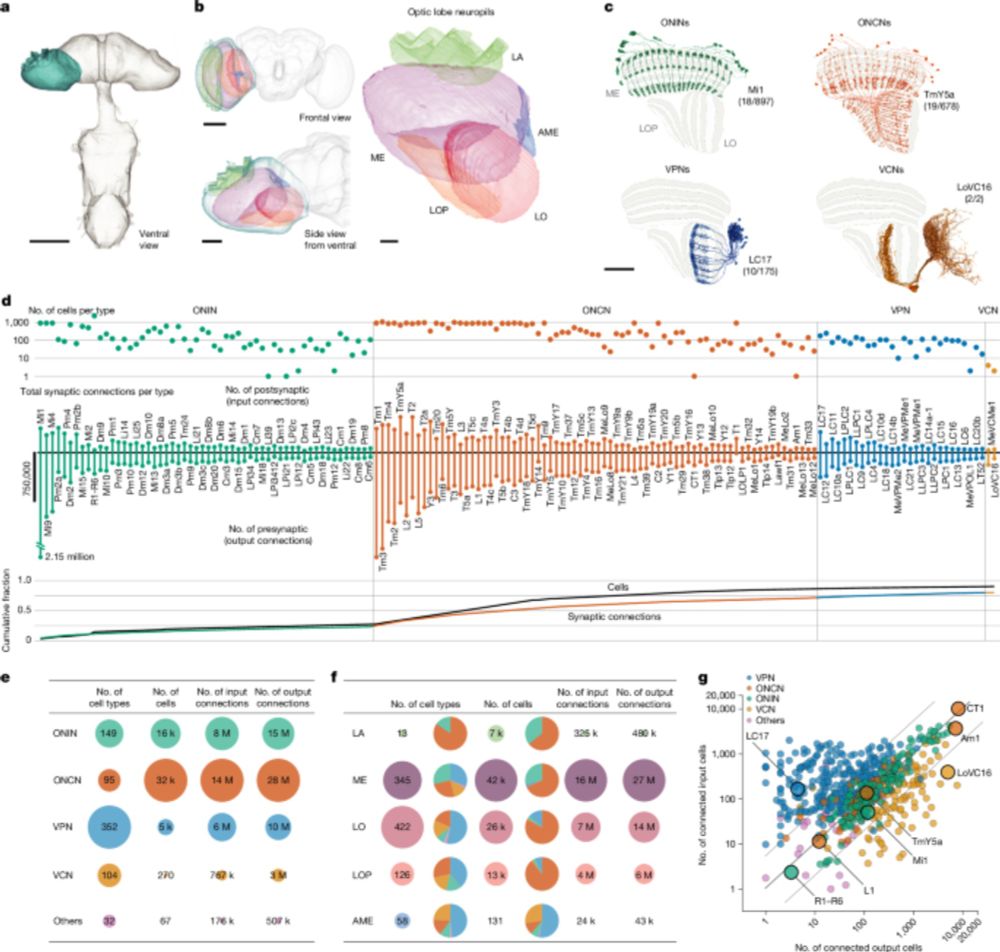
Connectome-driven neural inventory of a complete visual system - Nature
A connectome of the right optic lobe from a male fruitfly is presented together with an extensive collection of genetic drivers matched to a comprehensive neuron-type catalogue.
www.nature.com
March 27, 2025 at 10:58 PM
I know there's a 𝒍𝒐𝒕 going on right now, but I couldn’t be prouder to share this long-incubated labor of love: the complete connectome of the male 𝐷𝑟𝑜𝑠𝑜𝑝ℎ𝑖𝑙𝑎 optic lobe 🧠🪰
🔗 www.nature.com/articles/s41...
🔗 www.nature.com/articles/s41...
Reposted by matthew capek
Neural circuits that link genetic variation to #behavior: This study of mate choice behavior in Heliconius cydno #butterflies shows that alterations to the peripheral nervous system, driven by genetic & gene expression differences, can alter essential behaviors 🧪 @plosbiology.org plos.io/4iHQDRd
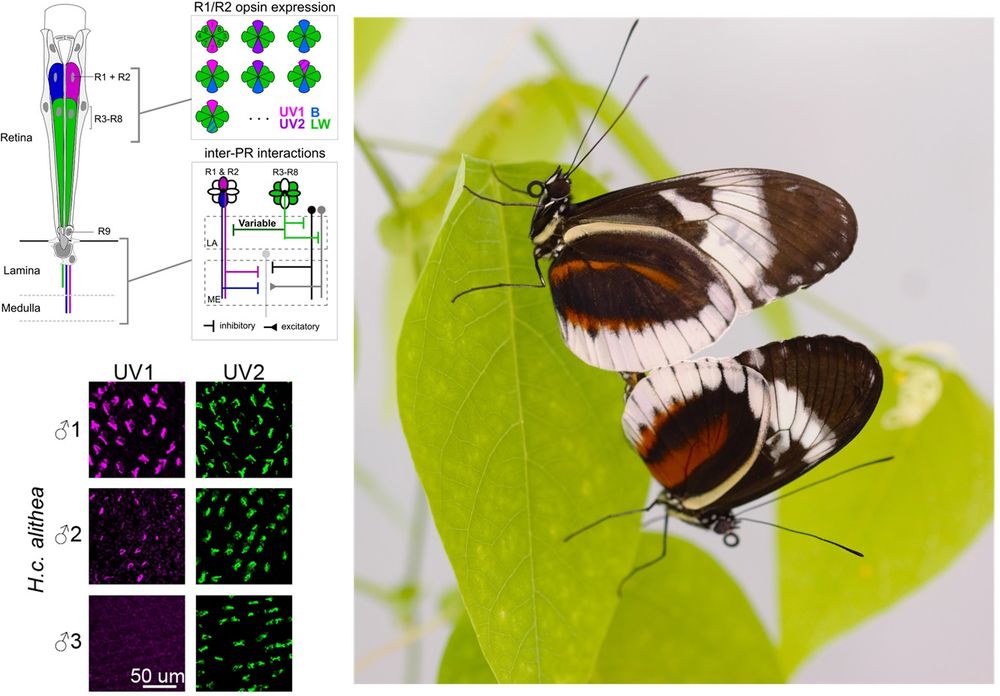
March 12, 2025 at 9:44 AM
Neural circuits that link genetic variation to #behavior: This study of mate choice behavior in Heliconius cydno #butterflies shows that alterations to the peripheral nervous system, driven by genetic & gene expression differences, can alter essential behaviors 🧪 @plosbiology.org plos.io/4iHQDRd
wild
Male blue-lined octopuses inject females with venom during mating to avoid being eaten by their partners
https://go.nature.com/3FqtOU4
https://go.nature.com/3FqtOU4
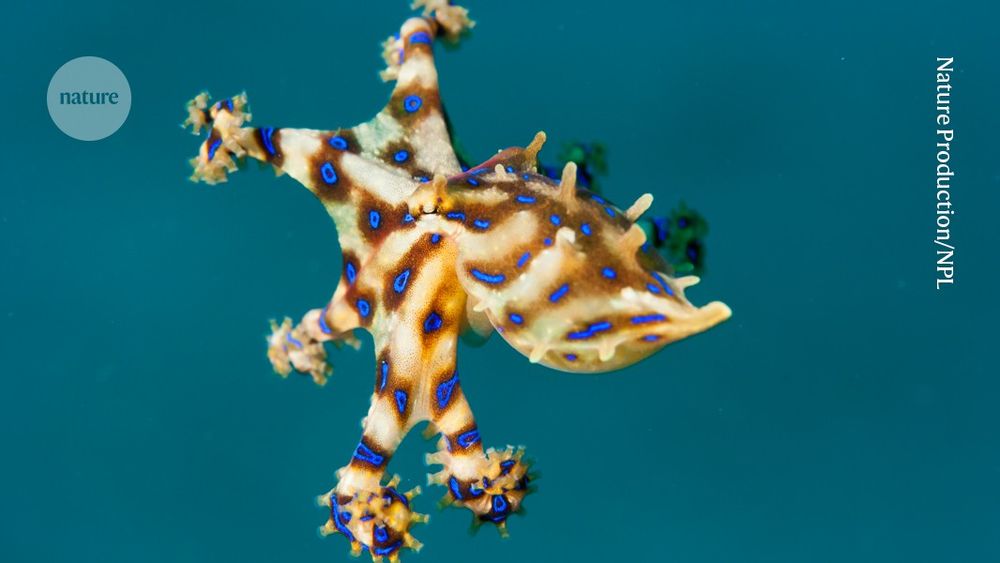
Bad romance: male octopuses inject deadly venom into their mates
The paralysing toxin deployed by the male blue-lined octopus might help to protect him from being eaten.
go.nature.com
March 12, 2025 at 3:17 PM
wild
🤘✨
Nature research paper: Evolution of temperature preference in flies of the genus Drosophila
https://go.nature.com/4i1VQn9
https://go.nature.com/4i1VQn9

Evolution of temperature preference in flies of the genus Drosophila - Nature
A study using flies of the genus Drosophila adapted to life in diverse thermal environments shows how evolution has shaped temperature preference by acting on both molecular heat receptors and thermosensory circuits in the flies.
go.nature.com
March 6, 2025 at 3:02 PM
🤘✨
🎉 so excited to share my first first-author paper is out in @Nature.com, from my PhD work in the Gallio Lab! we uncover the neurobiological mechanisms that drive the evolution of temperature preference behavior in flies of the genus Drosophila 👇
go.nature.com/4i1VQn9
go.nature.com/4i1VQn9
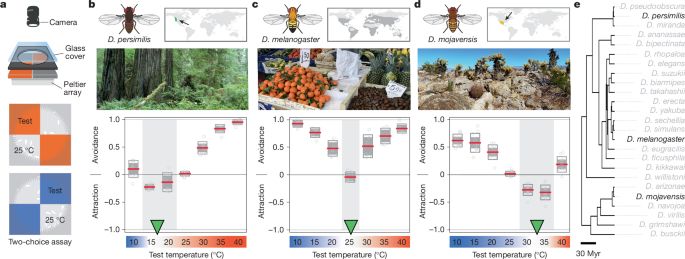
Evolution of temperature preference in flies of the genus Drosophila - Nature
A study using flies of the genus Drosophila adapted to life in diverse thermal environments shows how evolution has shaped temperature preference by acting on both molecular heat receptors and th...
go.nature.com
March 6, 2025 at 2:51 PM
🎉 so excited to share my first first-author paper is out in @Nature.com, from my PhD work in the Gallio Lab! we uncover the neurobiological mechanisms that drive the evolution of temperature preference behavior in flies of the genus Drosophila 👇
go.nature.com/4i1VQn9
go.nature.com/4i1VQn9

